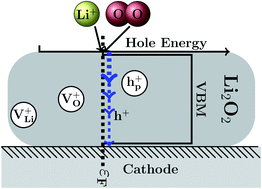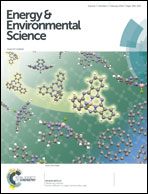Lithium and oxygen vacancies and their role in Li2O2 charge transport in Li–O2 batteries†
Abstract
It is now well accepted that charge transport through Li2O2 is a serious limitation in Li–O2 batteries. We report formation energies for the different charge states of Li, O and O2 vacancies in Li2O2 that could have important implications for charge transport through Li2O2. Charge transition levels are given as a function of the location of the Fermi level in Li2O2 relative to the valence band maximum (VBM). We argue that in Li–O2 discharge/charge electrochemistry, the Fermi level is pinned by LiO2 interface states at ∼0.35 eV above the VBM and this causes the vacancies to be in positively charged states (weakly violating local charge neutrality). We show by non-equilibrium Greens function calculations of charge transport through a Au|Li2O2 + VLiq |Au metal–insulator–metal structure (with VLiq a Li vacancy of charge state q), that the +1 and 0 charge state induces considerable scattering for tunneling holes. This tunneling is the previously proposed dominant mechanism of charge transport in Li–O2 batteries at practical current densities at room temperature, although we also proposed a contribution from hole polaron migration at very low currents and higher temperatures. We suggest that scattering of the tunneling holes by the positively charged vacancies (and possibly hole polarons) is the origin of the resistive loss observed in Li–O2 discharges in bulk electrolysis cells (where other forms of resistance are negligible). Thus, we argue that charged vacancies hinder charge transport through Li2O2 in Li–O2 electrochemical discharges.


 Please wait while we load your content...
Please wait while we load your content...